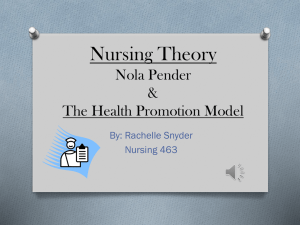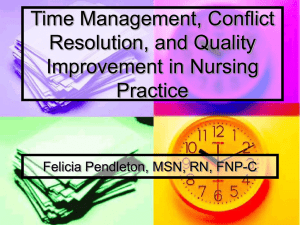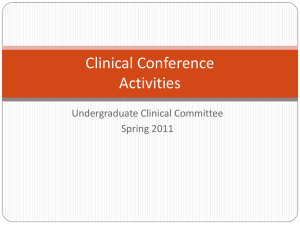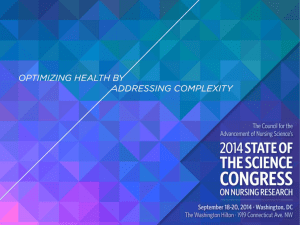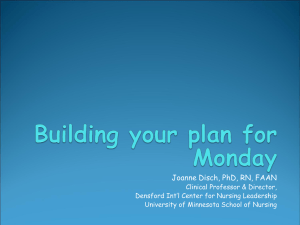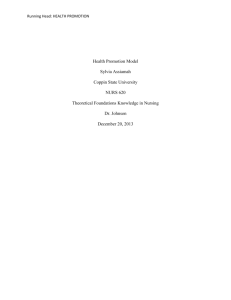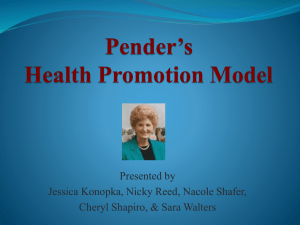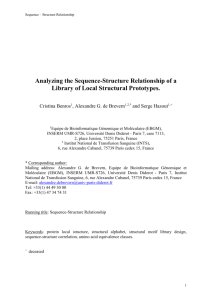Nola Pender by amy higgins and diane Morris
advertisement
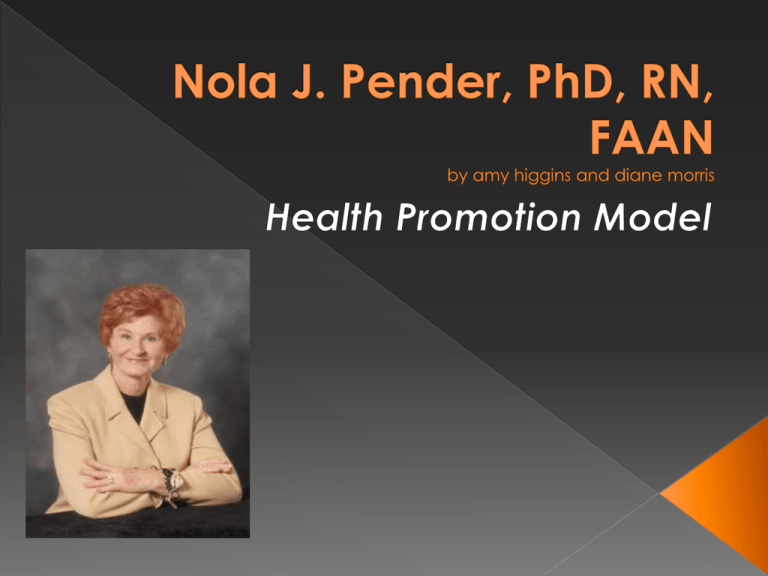
Born August 16, 1941 in Lansing, Michigan Education BS, Michigan State University, East Lansing, MI, 1964 MA, Michigan State University, East Lansing, MI, 1965 PhD, Northwestern University, Evanston, IL, 1969 Teaching Dr. Pender has been a nurse educator for over forty years. She has taught baccalaureate, masters, and PhD students; she also mentored a number of postdoctoral fellows. Currently, she serves as a Distinguished Professor at Loyola University Chicago, School of Nursing Interests Physical activity Adolescent health behaviors Health promotion Health behavior counseling Began studying Health Promoting Behavior in mid 1970’s First published Health Promotion Model 1982 Later revised in late 1980’s and again 1996 Considered a middle range theorist 1974: World Health Organization defines HEALTH as… “a state of complete physical, mental and social wellbeing and not merely the absence of disease and infirmity” 1979: The U.S. surgeon general published Healthy People which was a landmark document stating that major health advances would result from: Improved nutrition Increased physical fitness Personal Life styles Immunizations Environmental Modifications Pender proposed the Health Promotion Model (HPM) as a framework for integrating… Nursing Behavioral Science Perspectives Health Promotion Model …focuses on factors that influence Health Behaviors and is a guide to exploring biopsychosocial processes that motivate people to engage in behavior to enhance health 1. 2. 3. Major Concepts: Individual Characteristics and Experiences Behavior-Specific Cognitions and Affect Behavior Outcomes The Actualizing Tendency: “need to experience all facets of self and the world about them” (Pender, 1986). › Driving force toward ↑ levels of well-being › Individuals/Families are motivated to engage in health promoting behaviors when they know their own capacity for growth and potential The Stabilizing Tendency: is responsible for protective maneuvers, primarily maintaining internal & external environments within a range compatible with continuing existence…AKA “steady state” 1. 2. 3. 4. The HPM is based on the following assumptions, which reflect both nursing and behavioral science perspectives: Individuals seek to actively regulate their own behavior. Individuals in all their biopsychosocial complexity interact with the environment, progressively transforming the environment and being transformed over time. Health professionals constitute a part of the interpersonal environment, which exerts influence on persons throughout their lifespan. Self-initiated reconfiguration of person-environment interactive patterns is essential to behavior change Society Individuals Communities Framework of Health Promotion Concepts Health Promotion Families Health Protection Communities at large Nursing centers Workplace Schools Hospitals Progress toward Health Promotion is “slowed by vested interests in the economic gains inherent in ‘illnessoriented’ care and by political concerns about national debt and the high cost of health services” (Pender, 1986). “Ultimate goal is empowerment of client for selfdetermination and self management in order to enable attainment of high level health and wellbeing” (Pender, 1986). Based on: 1) Individual and family ultimately responsible for own health 2) Clients have inherent capacity for change in both constructive and destructive directions 3) Clients have a right to health information in order to make informed decisions concerning behavior and lifestyle choices The health promotion model (HPM) was designed to be a “complementary counterpart to models of health protection.” It defines health as a positive dynamic state not merely the absence of disease. Health promotion is directed at increasing a client’s level of wellbeing. The health promotion model describes the multi dimensional nature of persons as they interact within their environment to pursue health. Significance › Are metaparadigm concepts and propositions addressed by the theory explicit? › Are the philosophical claims on which the theory is based explicit? › Is the conceptual model on which the theory was derived explicit? › Are the authors of antecedent knowledge acknowledged and citations given? Internal Consistency › Are the context (philosophy and conceptual model) and the content (concepts and propositions) of the theory congruent? › Do the concepts reflect semantic clarity and consistency? Parsimony › Is the theory content stated clearly and concisely? Testability › Is the research methodology identified and congruent with philosophical claims? › Will data obtained from research sufficiently capture the essence of the theory? Empirical Adequacy › Are the findings from studies of descriptions of personal experiences congruent with the concepts and theory propositions? › Are theoretical assertions congruent with emperical evidence? Pragmatic Adequacy › Are education and special training required before › › › › application of the theory in nursing practice? Has the theory been applied in the real world of nursing practice? Is it generally feasible to implement practice derived from the theory? Does the practitioner have the legal ability to implement and measure the effectiveness of theorybased nursing actions? Is the application of theory-based nursing action designed so that comparisons can be made between outcomes of use of the theory and outcomes in the same situation when the theory was not used? Pender, N. J. (1987). Health promotion in nursing practice (2 ed.). Norwalk, Connecticut. http://currentnursing.com/nursing_theory/h ealth_promotion_model.html http://www.nursingtheory.com http://www.umich.edu/faculty-staff/nola-jpender McEwen, M., & Willis, E. M. (2007). Theoretical basis for nursing (3 ed.). Philadelphia, PA: Lippincott Williams & Wilkins.
